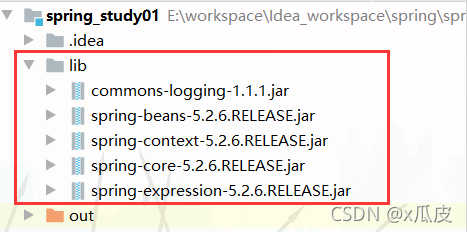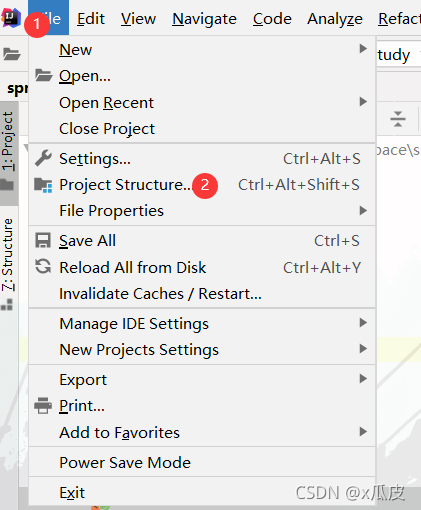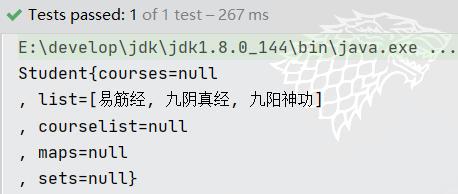-
Spring下载网址(本次学习使用5.2.6版本):
JFrog![]() https://repo.spring.io/ui/native/release/org/springframework/spring/
https://repo.spring.io/ui/native/release/org/springframework/spring/
-
Spring介绍:
优点:
- Spring是一个开源的免费的框架(容器)
- Spring是一个轻量级的、非入侵式的框架
- 控制反转(IOC),面向切面编程(AOP)
- 支持事务的处理,对框架整合的支持
特点:
- 方便解耦,简化开发
- Aop 编程支持
- 方便程序测试
- 方便和其他框架进行整合
- 方便进行事务操作
- 降低 API 开发难度
-
Spring所需的基本jar包:

导入方式:先存放到lib文件夹中



1、入门项目:
-
先看整体布局:

-
User.java:
package com.xyx.Spring5;
/**
* @author yuxing
* @create 2021-11-09-18:00
*/
public class User {
public void study(){
System.out.println("study----------01");
}
}-
bean.xml:
创建Spring配置文件,在配置文件配置创建的对象
<?xml version="1.0" encoding="UTF-8"?>
<beans xmlns="http://www.springframework.org/schema/beans"
xmlns:xsi="http://www.w3.org/2001/XMLSchema-instance"
xsi:schemaLocation="http://www.springframework.org/schema/beans http://www.springframework.org/schema/beans/spring-beans.xsd">
<!--配置User对象创建-->
<bean id="user" class="com.xyx.Spring5.User"></bean>
</beans>-
TestSpring5.java:
编写测试代码
package com.xyx.Spring5.testdemo;
import com.xyx.Spring5.User;
import org.junit.Test;
import org.springframework.context.ApplicationContext;
import org.springframework.context.support.ClassPathXmlApplicationContext;
/**
* @author yuxing
* @create 2021-11-09-18:03
*/
public class TestSpring5 {
@Test
public void testStudy(){
ApplicationContext context =
new ClassPathXmlApplicationContext("bean.xml");
User user = context.getBean("user",User.class);
user.study();
}
}运行结果:

2、IOC(概念与原理)
-
IOC思想基于IOC容器完成,IOC容器底层就是对象
-
入门案例就是IOC实现
(1)概念:
-
控制反转,把对象创建和对象的调用过程交给spring进行管理。
-
使用IOC目的:降低耦合度。
-
底层原理:xml,反射,工厂模式
-
Spring提供IOC容器两种实现方式(两个接口)
Bean管理是指两个操作:Spring创建对象 和 Spring注入属性
Bean管理有两种操作方式:基于xml配置文件方式实现 和 基于注解方式实现
2.1、IOC操作Bean管理(基于xml)
-
基于xml配置文件实现Bean管理:(包括创建对象和注入属性)
(1)基于xml方式创建对象:

?1. 在Spring配置文件中,使用bean标签,标签里添加对应属性,就可以实现对象创建 ?2. 在bean标签有很多属性,介绍常用的属性 ? ? 1. id属性:唯一标识符 ? ? 2. class属性:类全路径(包类路径) ?3. 创建对象时候,默认也是执行无参构造方法完成对象创建
(2)基于xml方式进行注入属性:
-
第一种注入方式——使用set方法注入:
Book.java
public class Book {
private String bname;
private String bauthor;
public void setBname(String bname) {
this.bname = bname;
}
public void setBauthor(String bauthor) {
this.bauthor = bauthor;
}
public void testDemo(){
System.out.println(bname+":::"+bauthor);
}
}bean.xml
<bean id="book" class="com.xyx.Spring5.test02.Book">
<!--使用property完成属性注入
name:类里面属性名称
value:向属性注入的值-->
<property name="bname" value="巴啦啦"></property>
<property name="bauthor" value="巴啦啦"></property>
</bean>测试类:test.java:
package com.xyx.Spring5.test02;
import org.junit.Test;
import org.springframework.context.ApplicationContext;
import org.springframework.context.support.ClassPathXmlApplicationContext;
/**
* @author yuxing
* @create 2021-11-09-19:05
*/
public class test {
@Test
public void testbook(){
ApplicationContext context =
new ClassPathXmlApplicationContext("bean1.xml");
Book book = context.getBean("book",Book.class);
book.testDemo();
}
}运行截图:

-
第二种注入方式——使用有参构造进行注入:
Orders.java:
package com.xyx.Spring5.test03;
/**
* @author yuxing
* @create 2021-11-09-19:13
*/
public class Orders {
private String oname;
private String address;
public Orders(String oname, String address111) {
this.oname = oname;
this.address = address111;
}
public void testDemo(){
System.out.println(oname+"::"+address);
}
}bean1.xml:
<!-- 配置Orders对象创建 及有参构造注入属性 -->
<bean id="orders" class="com.xyx.Spring5.test03.Orders">
<!--使用constructor-arg完成属性注入
index表示有参构造函数中的参数编号
name表示有擦构造函数中的参数名
value表示向属性注入的值
-->
<constructor-arg index="0" value="电脑" ></constructor-arg>
<constructor-arg name = "address111" value="CHINA" ></constructor-arg>
</bean>test.java:
package com.xyx.Spring5.test03;
import org.junit.Test;
import org.springframework.context.ApplicationContext;
import org.springframework.context.support.ClassPathXmlApplicationContext;
/**
* @author yuxing
* @create 2021-11-09-19:05
*/
public class test {
@Test
public void testbook(){
ApplicationContext context =
new ClassPathXmlApplicationContext("bean1.xml");
Orders orders = context.getBean("orders",Orders.class);
orders.testDemo();
}
}
运行截图:

-
第三种注入方式——使用p名称空间进行注入:
实体类与测试类相同,仅展示配置文件:
需要注意的是beans中多了一个(xmlns:p="http://www.springframework.org/schema/p"):
-
添加p名称空间在配置文件中
-
进行属性注入在bean标签里面进行操作
<?xml version="1.0" encoding="UTF-8"?>
<beans xmlns="http://www.springframework.org/schema/beans"
xmlns:xsi="http://www.w3.org/2001/XMLSchema-instance"
xmlns:p="http://www.springframework.org/schema/p"
xsi:schemaLocation="http://www.springframework.org/schema/beans http://www.springframework.org/schema/beans/spring-beans.xsd">
<bean id="book" class="com.xyx.Spring5.test04.Book" p:bname="九阳神功" p:bauthor="无名氏">
</bean>
</beans>运行截图:

2.2、IOC操作Bean管理(xml注入其他类型属性)
-
字面量
1)null值
<property name="address">
<null/>
</property>(2)属性值包含特殊符号
<!--属性值包含特殊符号
1 把<>进行转义 < >
2 把带特殊符号内容写到 CDATA
--><property name="address">
<value><![CDATA[<<南京>>]]></value>
</property>2. 注入外部属性——外部bean
(1)创建两个类 service 类和 dao 类
package com.xyx.Spring5.test05;
/**
* @author yuxing
* @create 2021-11-09-19:34
*/
public class UserDao {
public void update(){
System.out.println("UserDao中的update");
}
}(2)在 service 调用 dao 里面的方法
package com.xyx.Spring5.test05;
/**
* @author yuxing
* @create 2021-11-09-19:34
*/
public class UserService {
//创建 UserDao 类型属性,生成 set 方法
private UserDao userDao;
public void setUserDao(UserDao userDao) {
this.userDao = userDao;
}
public void add() {
System.out.println("service中的add...............");
userDao.update();
}
}(3)在 spring 配置文件中进行配置
<?xml version="1.0" encoding="UTF-8"?>
<beans xmlns="http://www.springframework.org/schema/beans"
xmlns:xsi="http://www.w3.org/2001/XMLSchema-instance"
xsi:schemaLocation="http://www.springframework.org/schema/beans http://www.springframework.org/schema/beans/spring-beans.xsd">
<!--1 service 和 dao 对象创建-->
<bean id="userService" class="com.xyx.Spring5.test05.UserService">
<!--注入 userDao 对象
name 属性:类里面属性名称
ref 属性:创建 userDao 对象 bean 标签 id 值
-->
<property name="userDao" ref="userDaoImpl"></property>
</bean>
<bean id="userDaoImpl" class="com.xyx.Spring5.test05.UserDao"></bean>
</beans>测试类:
package com.xyx.Spring5.test05;
import com.xyx.Spring5.test04.Book;
import org.junit.Test;
import org.springframework.context.ApplicationContext;
import org.springframework.context.support.ClassPathXmlApplicationContext;
/**
* @author yuxing
* @create 2021-11-09-19:05
*/
public class test {
@Test
public void testUserService(){
ApplicationContext context =
new ClassPathXmlApplicationContext("bean3.xml");
UserService userService = context.getBean("userService", UserService.class);
userService.add();
}
}运行截图:

-
注入属性——内部bean
(1)一对多关系:部门和员工;一个部门有多个员工,一个员工属于一个部门;部门是一,员工是多
(2)在实体类之间表示一对多关系,员工表示所属部门,使用对象类型属性进行表示
部门类(Dept.java):
package com.xyx.Spring5.test06;
/**
* @author yuxing
* @create 2021-11-09-19:42
*/
public class Dept {
private String dname;
public void setDname(String dname) {
this.dname = dname;
}
@Override
public String toString() {
return "Dept{" +
"dname='" + dname + '\'' +
'}';
}
}员工类(Emp.Java):
package com.xyx.Spring5.test06;
/**
* @author yuxing
* @create 2021-11-09-19:43
*/
public class Emp {
private String ename;
private String gender;
//员工属于某一个部门,使用对象形式表示
private Dept dept;
public void setDept(Dept dept) {
this.dept = dept;
}
public void setEname(String ename) {
this.ename = ename;
}
public void setGender(String gender) {
this.gender = gender;
}
@Override
public String toString() {
return "Emp{" +
"ename='" + ename + '\'' +
", gender='" + gender + '\'' +
", dept=" + dept +
'}';
}
}配置文件(bean3.xml)解释看代码中的备注:
<!--内部 bean-->
<bean id="emp01" class="com.xyx.Spring5.test06.Emp">
<!--设置两个普通属性-->
<property name="ename" value="lucy"></property>
<property name="gender" value="女"></property>
<!--设置对象类型属性-->
<property name="dept"> <!--意为:为Emp中的dept赋值,由于此值的类型为Dept,所以接下来创建Dept对象-->
<bean id="dept" class="com.xyx.Spring5.test06.Dept"> <!--创建Dept对象-->
<property name="dname" value="安保部"></property> <!--为Dept对象中的dname赋值为安保部-->
</bean>
</property>
</bean>测试类(test.java):
package com.xyx.Spring5.test06;
import com.xyx.Spring5.test05.UserService;
import org.junit.Test;
import org.springframework.context.ApplicationContext;
import org.springframework.context.support.ClassPathXmlApplicationContext;
/**
* @author yuxing
* @create 2021-11-09-19:05
*/
public class test {
@Test
public void testbook(){
ApplicationContext context =
new ClassPathXmlApplicationContext("bean3.xml");
Emp emp = context.getBean("emp01", Emp.class);
System.out.println(emp.toString());
}
}运行截图:

4、注入属性——级联赋值
写法一:
在上方:注入属性——内部bean的基础上改进:只需改进xml配置文件:
<!--级联赋值--> <!--test06-->
<bean id="emp02" class="com.xyx.Spring5.test06.Emp">
<!--设置两个普通属性-->
<property name="ename" value="lucy"></property>
<property name="gender" value="女"></property>
<!--级联赋值-->
<property name="dept" ref="dept"></property> <!--dept为对象-->
</bean>
<bean id="dept" class="com.xyx.Spring5.test06.Dept"><!--为对象赋值-->
<property name="dname" value="财务部"></property>
</bean>运行截图:

写法二:
同理对上方内容进行改进:
对员工类中的部门属性添加get方法:
//员工属于某一个部门,使用对象形式表示
private Dept dept;
public Dept getDept() {
return dept;
}配置文件(bean3.xml):
<!--级联赋值--> <!--test06-->
<bean id="emp03" class="com.xyx.Spring5.test06.Emp">
<!--设置两个普通属性-->
<property name="ename" value="lucy"></property>
<property name="gender" value="女"></property>
<!--级联赋值-->
<property name="dept" ref="dept03"></property> <!--意为Emp中的dept属性赋值为dept03该对象-->
<property name="dept.dname" value="技术部"></property><!--意为dept对象中的dname赋值为技术部-->
</bean>
<bean id="dept03" class="com.xyx.Spring5.test06.Dept">
</bean>运行截图:

总结一:(内部bean和级联赋值)
实际上就是一步步将内部bean中的对象逐渐分离出来,在级联赋值中二者区别为关键赋值一个在dept对象中一个在emp对象中。效果实际一样。
2.3、IOC 操作Bean管理(xml注入集合属性)
1、注入数组类型属性
2、注入List 集合类型属性
3、注入Map集合类型属性
创建类,定义数组、lis、map、set类型属性,生成对应的set方法:
package com.xyx.Spring5.test07;
import java.util.Arrays;
import java.util.List;
import java.util.Map;
import java.util.Set;
/**
* @author yuxing
* @create 2021-11-10-11:16
*/
public class Student {
//1 数组类型属性
private String[] courses;
//2 list 集合类型属性
private List<String> list;
//3 map 集合类型属性
private Map<String,String> maps;
//4 set 集合类型属性
private Set<String> sets;
public void setSets(Set<String> sets) {
this.sets = sets;
}
public void setCourses(String[] courses) {
this.courses = courses;
}
public void setList(List<String> list) {
this.list = list;
}
public void setMaps(Map<String, String> maps) {
this.maps = maps;
}
@Override
public String toString() {
return "Student{" +
"courses=" + Arrays.toString(courses) +
", list=" + list +
", maps=" + maps +
", sets=" + sets +
'}';
}
}配置文件(bean4.xml):
<?xml version="1.0" encoding="UTF-8"?>
<beans xmlns="http://www.springframework.org/schema/beans"
xmlns:xsi="http://www.w3.org/2001/XMLSchema-instance"
xsi:schemaLocation="http://www.springframework.org/schema/beans http://www.springframework.org/schema/beans/spring-beans.xsd">
<!--1 集合类型属性注入-->
<bean id="student" class="com.xyx.Spring5.test07.Student">
<!--数组类型属性注入-->
<property name="courses">
<array>
<value>java 课程</value>
<value>数据库课程</value>
</array>
</property>
<!--list 类型属性注入-->
<property name="list">
<list>
<value>张三</value>
<value>小三</value>
</list>
</property>
<!--map 类型属性注入-->
<property name="maps">
<map>
<entry key="JAVA" value="java"></entry>
<entry key="PHP" value="php"></entry>
</map>
</property>
<!--set 类型属性注入-->
<property name="sets">
<set>
<value>MySQL</value>
<value>Redis</value>
</set>
</property>
</bean>
</beans>测试类:
package com.xyx.Spring5.test07;
import com.xyx.Spring5.test06.Emp;
import org.junit.Test;
import org.springframework.context.ApplicationContext;
import org.springframework.context.support.ClassPathXmlApplicationContext;
/**
* @author yuxing
* @create 2021-11-09-19:05
*/
public class test {
@Test
public void testbook(){
ApplicationContext context =
new ClassPathXmlApplicationContext("bean4.xml");
Student student = context.getBean("student", Student.class);
System.out.println(student.toString());
}
}运行截图:

4、在集合里面设置对象类型值
添加一个类Course.java:
package com.xyx.Spring5.test07;
/**
* @author yuxing
* @create 2021-11-10-11:26
*/
public class Course {
private String cname;
public void setCname(String cname) {
this.cname = cname;
}
@Override
public String toString() {
return "Course{" +
"cname='" + cname + '\'' +
'}';
}
}Student中添加属性:
//2 list 对象集合类型属性
private List<Course> courselist;
public void setCourselist(List<Course> courselist) {
this.courselist = courselist;
}配置文件中添加:
<!--注入 list 集合类型,值是对象-->
<property name="courselist">
<list>
<ref bean="course1"></ref>
<ref bean="course2"></ref>
</list>
</property>
<!--注意以上部分要添加到Student对象中-->
<bean id="course1" class="com.xyx.Spring5.test07.Course">
<property name="cname" value="Spring5 框架"></property>
</bean>
<bean id="course2" class="com.xyx.Spring5.test07.Course">
<property name="cname" value="MyBatis 框架"></property>
</bean>运行结果:

5、把集合注入部分提取出来
(1)在 spring 配置文件中引入名称空间 util
<beans xmlns="http://www.springframework.org/schema/beans"
xmlns:xsi="http://www.w3.org/2001/XMLSchema-instance"
xmlns:util="http://www.springframework.org/schema/util"
xsi:schemaLocation="http://www.springframework.org/schema/beans http://www.springframework.org/schema/beans/spring-beans.xsd
http://www.springframework.org/schema/util http://www.springframework.org/schema/util/spring-util.xsd">(2)使用 util 标签完成 list 集合注入提取
<!--1 提取 list 集合类型属性注入--> <!--test08-->
<util:list id="studentList">
<value>易筋经</value>
<value>九阴真经</value>
<value>九阳神功</value>
</util:list>
<!--2 提取 list 集合类型属性注入使用--> <!--test08-->
<bean id="student2" class="com.xyx.Spring5.test08.Student">
<property name="list" ref="studentList">
</property>运行截图:

2.4、IOC 操作Bean管理(FactoryBean)
1、Spring有两种类型 bean,一种普通bean,另外一种工厂bean (FactoryBean)
-
普通bean:在配置文件中定义bean类型就是返回类型
-
工厂bean:在配置文件定义bean类型可以和返回类型不一样
第一步:创建类,让这个类作为工厂bean,实现接口FactoryBean
第二步:实现接口里面的方法,在实现的方法中定义返回的bean类型
package com.xyx.Spring5.test09;
import org.springframework.beans.factory.FactoryBean;
/**
* @author yuxing
* @create 2021-11-11-10:34
*/
public class MyBean implements FactoryBean<Course> {
@Override
public Course getObject() throws Exception {
Course course = new Course();
course.setCname("工厂创建对象");
return course;
}
@Override
public Class<?> getObjectType() {
return null;
}
@Override
public boolean isSingleton() {
return false;
}
}配置文件:
<bean id="myBean" class="com.xyx.Spring5.test09.MyBean">
</bean>测试类:
package com.xyx.Spring5.test09;
import org.junit.Test;
import org.springframework.context.ApplicationContext;
import org.springframework.context.support.ClassPathXmlApplicationContext;
/**
* @author yuxing
* @create 2021-11-11-10:41
* @content:测试工厂方法创建对象
*/
public class test {
@Test
public void testFactoryBean(){
ApplicationContext context =
new ClassPathXmlApplicationContext("bean5.xml");
Course course = context.getBean("myBean", Course.class);
System.out.println(course);
}
}注意:这里的测试类里创建的是Course对象,但是在配置文件中我们创建的是MyBean对象;所以我们就要看看MyBean类中是怎么回事了,在MyBean中实现了FactoryBean<Course>接口,并且类型为Course。但是为什么会自己调用getObject()方法呢。其实本质不是这样的。
测试类中getBean方法的本质:当调用getBean("mybean")时,Spring通过反射机制发现MyBean实现了FactoryBean的接口,这时 Sping容器就调用接口方法CarFactoryBean中的getObject()返回工厂类创建的对象。如果用户希望获取 CarFactoryBean的实例,则需要在使用getBean(beanName)方法时显式地在beanName前加上“&”前 缀:getBean("&mybean")。
2.5、IOC操作Bean管理(bean作用域)
1、在Spring里面,设置创建bean实例是单实例还是多实例
2、在 Spring里面,默认情况下,bean是单实例对象
public class test {
@Test
public void testbook(){
ApplicationContext context =
new ClassPathXmlApplicationContext("bean1.xml");
Book book = context.getBean("book", Book.class);
Book book2 = context.getBean("book", Book.class);
System.out.println(book);
System.out.println(book2);
}
}运行结果:

3、如何设置单实例还是多实例
(1)在 spring 配置文件 bean 标签里面有属性(scope)用于设置单实例还是多实例
(2)scope 属性值:第一个值 默认值,singleton,表示是单实例对象
第二个值 prototype,表示是多实例对象

运行结果:

(3)singleton 和 prototype 区别
第一 singleton 单实例,prototype 多实例
第二 设置 scope 值是 singleton 时候,加载 spring 配置文件时候就会创建单实例对象
设置 scope 值是 prototype 时候,不是在加载 spring 配置文件时候创建 对象,在调用
getBean 方法时候创建多实例对象
2.6IOC操作Bean管理(bean生命周期)
1、生命周期
(1)从对象创建到对象销毁的过程
2、bean 生命周期
(1)通过构造器创建bean实例(无参数构造)
(2)为 bean 的属性设置值和对其他 bean 引用(调用 set 方法)
(3)调用 bean 的初始化的方法(需要进行配置初始化的方法)
(4)bean 可以使用了(对象获取到了)
(5)当容器关闭时候,调用 bean 的销毁的方法(需要进行配置销毁的方法)
3、演示bean生命周期
Orders.java
package com.xyx.Spring5.test11;
/**
* @author yuxing
* @create 2021-11-11-11:57
* @content:
*/
public class Orders {
//无参数构造
public Orders() {
System.out.println("第一步 执行无参数构造创建 bean 实例");
}
private String oname;
public void setOname(String oname) {
this.oname = oname;
System.out.println("第二步 调用 set 方法设置属性值");
}
//创建执行的初始化的方法
public void initMethod() {
System.out.println("第三步 执行初始化的方法");
}
//创建执行的销毁的方法
public void destroyMethod() {
System.out.println("第五步 执行销毁的方法");
}
}配置文件:
<!--test11-->
<bean id="orders" class="com.xyx.Spring5.test11.Orders" init-method="initMethod" destroy-method="destroyMethod">
<property name="oname" value="手机"></property>
</bean>测试类:
package com.xyx.Spring5.test11;
import org.junit.Test;
import org.springframework.context.ApplicationContext;
import org.springframework.context.support.ClassPathXmlApplicationContext;
/**
* @author yuxing
* @create 2021-11-09-19:05
*测试bean生命周期
*/
public class test {
@Test
public void test(){
// ClassPathXmlApplicationContext context =
// new ClassPathXmlApplicationContext("bean4.xml");
ApplicationContext context =
new ClassPathXmlApplicationContext("bean5.xml");
Orders orders = context.getBean("orders", Orders.class);
System.out.println("第四步 获取创建 bean 实例对象");
System.out.println(orders);
//手动让 bean 实例销毁
((ClassPathXmlApplicationContext)context).close();
}
}注意:在手动bean实例摧毁时,调用的close方法是ClassPathXmlApplicationContext中的方法,而不是ApplicationContext接口中的方法(该接口中没有close方法):所以使用了强转。
运行截图:
